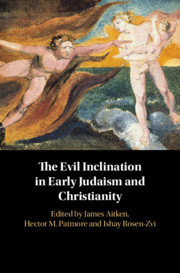Book contents
- The Evil Inclination in Early Judaism and Christianity
- The Evil Inclination in Early Judaism and Christianity
- Copyright page
- Contents
- Acknowledgments
- Contributors
- 1 Introduction
- 2 Reconsidering the Semantics of the “Inclination” (yeṣer) in Classical Biblical Hebrew
- 3 The “Inclination” (yeṣer) as Rendered in the Septuagint
- 4 “Fleshly Spirit” and “Vessel of Flesh” in 4QInstruction and the Thanksgiving Hymns
- 5 Theological Anthropology in the Enochic Tradition
- 6 The Perils of Philosophical Persuasion: Philo on the Origin of Moral Evils
- 7 The Evil Inclination (yeṣer ha-ra‘) in Tannaitic Literature: Demonic Desires and Beyond
- 8 Conflicting Intrapersonal Powers in Paul’s Letters
- 9 The “Two Inclinations” and the Double-Minded Human Condition in the Letter of James
- 10 An Evil Inclination in the Early Targums to the Pentateuch and Prophets?
- 11 “Gnostic” Theologies of Evil
- 12 The Rabbinic “Inclination” (yeṣer) and the Christian Apocrypha
- 13 Origen on the Origin of Sin
- 14 Augustine on the Diabolical Suggestion of Sin
- 15 Jerome and the “Inclination” (yeṣer): The Evidence of the Vulgate
- 16 Rabbinic Inclinations and Monastic Thoughts: Evagrius Ponticus’ Doctrine of Reasoning (logismoi) and Its Antecedents
- 17 “Inclination” (yaṣrā) in the Syriac Tradition
- 18 Evil, Sin, and Inclination (yeṣer) in Jewish and Christian Poetic Disputes between the Body and Soul
- 19 The Wizard of Āz and the Evil Inclination: The Babylonian Rabbinic Inclination (yeṣer) in Its Zoroastrian and Manichean Context
- 20 The Evil Inclination in the Targums to the Writings
- References
- Index of Names
- Index Locorum
15 - Jerome and the “Inclination” (yeṣer): The Evidence of the Vulgate
Published online by Cambridge University Press: 02 February 2021
- The Evil Inclination in Early Judaism and Christianity
- The Evil Inclination in Early Judaism and Christianity
- Copyright page
- Contents
- Acknowledgments
- Contributors
- 1 Introduction
- 2 Reconsidering the Semantics of the “Inclination” (yeṣer) in Classical Biblical Hebrew
- 3 The “Inclination” (yeṣer) as Rendered in the Septuagint
- 4 “Fleshly Spirit” and “Vessel of Flesh” in 4QInstruction and the Thanksgiving Hymns
- 5 Theological Anthropology in the Enochic Tradition
- 6 The Perils of Philosophical Persuasion: Philo on the Origin of Moral Evils
- 7 The Evil Inclination (yeṣer ha-ra‘) in Tannaitic Literature: Demonic Desires and Beyond
- 8 Conflicting Intrapersonal Powers in Paul’s Letters
- 9 The “Two Inclinations” and the Double-Minded Human Condition in the Letter of James
- 10 An Evil Inclination in the Early Targums to the Pentateuch and Prophets?
- 11 “Gnostic” Theologies of Evil
- 12 The Rabbinic “Inclination” (yeṣer) and the Christian Apocrypha
- 13 Origen on the Origin of Sin
- 14 Augustine on the Diabolical Suggestion of Sin
- 15 Jerome and the “Inclination” (yeṣer): The Evidence of the Vulgate
- 16 Rabbinic Inclinations and Monastic Thoughts: Evagrius Ponticus’ Doctrine of Reasoning (logismoi) and Its Antecedents
- 17 “Inclination” (yaṣrā) in the Syriac Tradition
- 18 Evil, Sin, and Inclination (yeṣer) in Jewish and Christian Poetic Disputes between the Body and Soul
- 19 The Wizard of Āz and the Evil Inclination: The Babylonian Rabbinic Inclination (yeṣer) in Its Zoroastrian and Manichean Context
- 20 The Evil Inclination in the Targums to the Writings
- References
- Index of Names
- Index Locorum
Summary
By the time of Jerome’s birth in the first half of the fourth century CE, the rabbinic Sages had become well accustomed to speaking of the bad yeṣer and the good yeṣer as constituent elements in the make-up of the individual human being. The two expressions are already found side by side at m. Ber. 9:5, interpreting Deut 6:5. Their place in what is an exegetical setting illustrates that the idea of the yeṣer had its home not in speculation, but in learned exposition of Scripture. While rabbinic writings later than the Mishnah continue to speak of both the good and the bad yeṣer, references to and discussion of the latter, simply designated “the yeṣer,” often predominate to the exclusion of the good yeṣer.
- Type
- Chapter
- Information
- The Evil Inclination in Early Judaism and Christianity , pp. 232 - 246Publisher: Cambridge University PressPrint publication year: 2021

